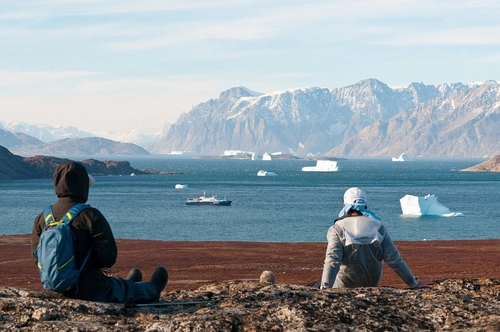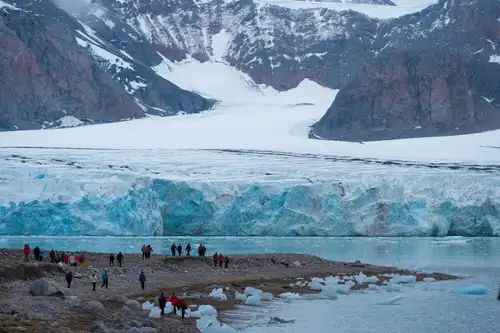
It isn’t always bitterly cold either.

The locals don’t all live in igloos.

And there isn’t a polar bear lurking around every corner.

Although you can indeed find them if you put in some effort (and have a little luck).

Greenland isn’t just one big sheet of ice.

Although snow and glaciation can make for some breath-takingly beautiful vistas.

Sure, Greenland is great for iceberg-spotting.

But this is a Greenland cruise after all.

So come aboard.

Set sail for the land of the midnight sun.

Explore pristine waters.

Viking history.

Geology.

And of course the wildlife. Musk Oxen.

Birds.

Seals.

And whales.

Make no mistake, you’ll be happy that you did.

Best Deals

Spitsbergen - Northeast Greenland, Fly & Sail
$ 9.500

Northeast Greenland Extreme
$ 8.650

East Greenland, Scoresby Sund, Including Long Hikes
$ 6.000

Northeast Greenland Extreme
$ 7.850

East Greenland, Scoresby Sund - Aurora Borealis, Fly & Sail
$ 6.250
Related Trips
Blog



Blog
How Arctic Wildlife Differs from Antarctic
While the north and south poles share certain characteristics, they are also remarkably distinct. Both regions are cold and dry, yet each has its own unique terrain and climate. The Antarctic is particularly harsh and inhospitable, with only two native vascular plant species, whereas the Arctic tundra supports a wider range of fauna due to its relatively warmer temperatures and greater plant diversity. Here are some of the animals you can find in the Arctic compared to the Antarctic.

Blog
Two for the Snow: Polar Cruises for Couples
Do you know the old saying, âCold hands, warm heartâ? In our opinion, that bodes well for couples who visit the polar regions.

Blog
11 Seals You May See in Antarctica or the Arctic
1. Weddell seals â These seals are known for their calm demeanor and spend most of their lives beneath the Antarctic ice. Although they need to come up for air, they can remain underwater for up to 45 minutes. Weddell seals can dive to depths of 610 meters (2,000 feet) in search of food. These vocal animals usually have one pup annually and can grow up to 3 meters (10 feet) and weigh 544 kg (1,200 lbs).

Blog
16 Conversation-Starting Svalbard Facts
It might seem odd that an icy, snowy, bear-packed cluster of islands at the edge of the world could be such a hotspot (so to speak) of outdoor tourism.

Blog
What’s so Special about East Spitsbergen?
Weâve previously discussed our north Spitsbergen journeys and Spitsbergen circumnavigations, but the eastern parts of this incredible island have not received the attention they deserve. Despite the name, our east Spitsbergen voyages explore much more than just the eastern side of Spitsbergen.

Blog
Large and in Charge: Antarctica’s Southern Elephant Seals
Southern elephant seals are the largest species of seal on the planet and a highlight among Antarctica cruise wildlife.

Blog
15 Toothy Facts About the Atlantic Walrus
The walrus is one of the most recognizable animals on the planet, and for good reason. Try sneaking into a cinema with those tusks!

Blog
The Wonderful Weddell Sea: Places, Pics, and Impressions
When we talk about Antarctica, itâs easy to slip into familiar words: amazing, astounding, extraordinary, exceptional. And though most Antarctic locations more than deserve these descriptions, some deserve them more than others.

Blog
A Diving Dream Fulfilled
Last January, Mark Hatter achieved a dream heâd been training for over two years. Booking his berth aboard the m/v Ortelius and making the long flight to Ushuaia, Argentina, he and two of his friends sailed down the famous Drake Passage, bound for Earthâs southernmost continent. But their Antarctica trip was not just about shoreline walks and photographing penguins.

Blog
Albatross, penguin and krill research in Antarctica
In the Antarctic region, extensive research is being conducted by national Antarctic programmes from countries like the UK, Australia, and Japan. These studies aim to understand species in the air, on the ground, and in the sea, and how these species are interconnected without variables such as human impacts and climate change.

Blog
Discover the Scoresby Sund Fjord System in East Greenland
Are you considering a trip to Greenland? One destination you absolutely must visit is the world's largest fjord with stunning landscapes: Scoresby Sund.

Blog
Peaks, Fjords, and Auroras: 14 East Greenland Attractions
There really arenât enough superlatives for East Greenland.

Blog
Svalbard a Disneyland for geologists
Svalbard is situated in the north-western corner of the Eurasian plate. Historically, Svalbard was part of a vast continent that included North America, Greenland, and Eurasia. At one point, both Northeast Greenland and Svalbard were submerged under the ocean before resurfacing.

Blog
Arctic Mythology: Inuit, Saami, and the Ancient Greeks
The Arctic locations we visit arenât merely made up of phenomenal landscapes, exotic wildlife, and more adventure than a Hardy Boys novel.

Blog
The Small Mammals of the Arctic and Antarctica
As Lillian Gish says in Night of the Hunter, âItâs a hard world for little things.â

Blog
Weddell Sea: the Original Antarctic Adventure
According to historian Thomas R. Henry, visiting the Weddell Sea requires a brave heart. In his 1950 book, "The White Continent," he described sudden âflash freezesâ that occur in the region. It was one of these flash freezes that trapped Ernest Shackletonâs ship, Endurance, in January 1915, forcing his crew to endure over a year in the harsh environment before they could escape.

Blog
The Norse Settlement of Greenland
Erik the Red is a significant and vibrant figure in the history of the Norse Vikings. His story is primarily documented in the Icelandic Sagas Huaksbók (14th Century) and Skalhóltsbók (15th Century). These accounts offer slightly different versions of events that occurred 3-400 years earlier. The original saga of Erik the Red is believed to have been written around 1200 A.D., with the Skalhóltsbók version considered closest to the original. Additionally, Flateyjarbók (13th Century), which includes the Saga of the Greenlanders, is a crucial source for understanding the settlement of Greenland and the discovery of Vinland â North America.

Blog
Antarctica in Pictures: Photos from 2018
Pictures can never truly capture the essence of an experience, and this is especially true for the breathtaking adventures in Antarctica.

Blog
The Giant Petrels of King George Island
Antarctica is undeniably one of the worldâs premier birding destinations.

Blog
The Ancient Fossil Forests of Antarctica
Over a hundred years ago, Robert Falcon Scottâs expedition to Antarctica discovered fossils of plants on the Beardmore Glacier, less than 500 km (310 miles) from the South Pole. Edward Wilson, who was the expeditionâs chief scientist, recorded the findings in his diary, stating that âmost of the bigger leaves were like beech leaves in shape and venation.â





 20 Days / 19 Nights
20 Days / 19 Nights

